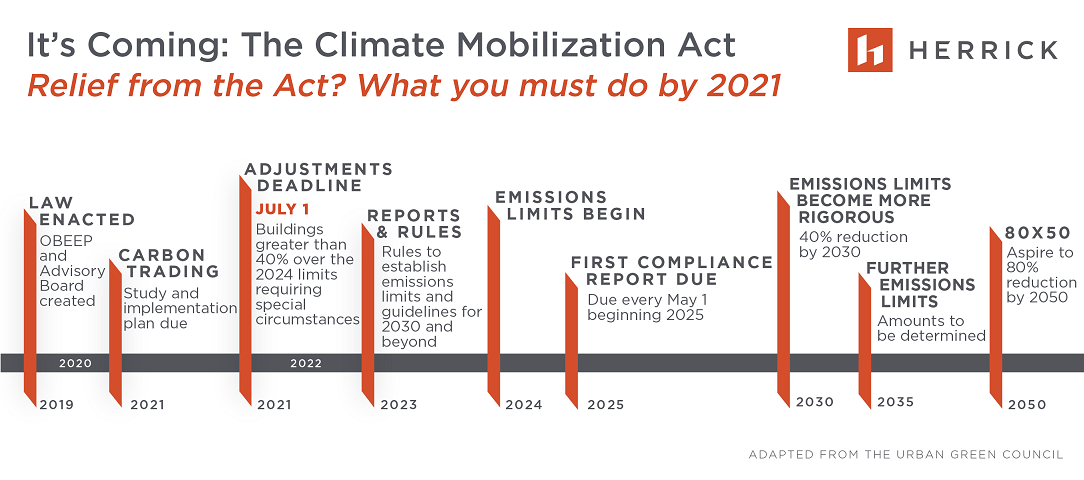The Climate Mobilization Act: Relief from the Act? What you must do by 2021
December 2019Article 2: Relief from the Act? What you must do by 2021
Adjustments Although the Climate Mobilization Act (CMA) applies to all Covered Buildings that do not fall under an exception, the Act states that certain Covered Buildings may apply for an adjustment to the emissions limit. However, the deadline to apply for an adjustment is July 1, 2021.
Adjustments are considered by the Office of Building Energy and Emissions Performance (OBEEP), which is permitted to raise the emissions limits for individual buildings based on the below circumstances.
An adjustment may be warranted if:
- The Covered Building is legally incapable of maintaining the limit (e.g., a landmark building);
- The Covered Building is physically incapable of maintaining the limit because of lack of access to energy infrastructure, space constraints or restrictions on access. In this case the owner must take reasonable efforts to overcome the incapability, and the adjustment will be effective for only three years or less;
- It is too costly for the owner to comply with the Act, and the owner proves it tried to avail itself of city programs aimed at assisting with compliance; or
- Special scenarios such as: (a) 24-hour buildings, (b) high-density buildings, or (c) buildings with high energy tenants. In these scenarios, however, the owner must show that (1) the Covered Building exceeded its emissions limits by 40% in 2018, (2) the owner followed the NYC Energy Conservation Code of 2015, and (c) the owner has developed a plan outlining compliance with the 2030–2035 emission limits.
Covered Buildings which meet any of the above circumstances may be an awarded an adjustment in their emissions limit, though adjustments are awarded at the discretion of OBEEP and it is not clear how OBEEP will weigh the foregoing factors.
Owners potentially seeking an adjustment should begin work now as the July 1, 2021 deadline requires that all prerequisites to the application be complete by this date. Specifically, owners will need to assess the Covered Building and its emissions limits, and likely will need to consult with a registered design professional and/or contractor, to determine whether the Covered Building is eligible for an adjustment.
Assistance In addition to relief through Adjustments, Local Law 96 of the Act also establishes the Property Assessed Clean Energy (PACE) program to assist owners with the costs of compliance with the Act. PACE is a long-term financing program which will offer low-interest and no-interest loans to qualifying owners for certain up-front costs of retrofitting of Covered Buildings with energy efficient projects. PACE loans will be repaid over the useful life of the improvements financed by the loan, with installment payments added as an additional line item to the qualifying Covered Building’s property tax bill. PACE could prove vital to owners as the Real Estate Board of New York has estimated that the cost of building retrofits across the city could exceed $4 billion.
Additional Relief Though light on specifics, the Act also contemplates permitting owners to purchase carbon offsets for non-compliant Covered Buildings and awarding renewable energy credits to Covered Buildings which generate renewable energy, which will be credited against the annual building emission limit of the qualifying building. Finally, the Act establishes an advisory group to study and consider a carbon trading program whereby Covered Buildings which exceed emissions limits can purchase credits from Covered Buildings which fall below the emissions threshold. We will continue to update you as more details about these components of the Act become available.
As to be expected, there are penalties for building owners who fail to comply with the new regulations. In early 2020, we will discuss the financial implications of non-compliance in Article 3: Fines, Fees, and Failure to Report.

For more information please reach out to:
Brendan Schmitt at +1 212 592 1689 or [email protected]
© 2019 Herrick, Feinstein LLP. This article is provided by Herrick, Feinstein LLP to keep its clients and other interested parties informed of current legal developments that may affect or otherwise be of interest to them. The information is not intended as legal advice or legal opinion and should not be construed as such.
